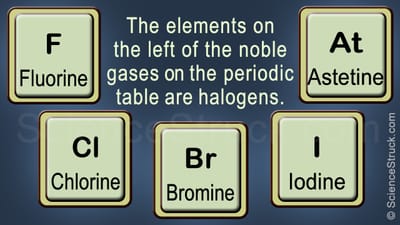About Halogens
The halogens are a group in the periodic table consisting of five chemically related elements: fluorine (F), chlorine (Cl), bromine (Br), iodine (I), and astatine (At). The symbol X is often used generically to refer to any halogen.
The name "halogen" means "salt-producing". When halogens react with metals they produce a wide range of salts, including calcium fluoride, sodium chloride (common table salt), silver bromide and potassium iodide.
The group of halogens is the only periodic table group that contains elements in three of the main states of matter at standard temperature and pressure. All of the halogens form acids when bonded to hydrogen. Most halogens are typically produced from minerals or salts. The middle halogens , that is chlorine, bromine and iodine, are often used as disinfectants. Organobromides are the most important class of flame retardants. Elemental halogens are dangerous and can be lethally toxic.
States of Matter at Room Temperature
(at Room Temperature)Halogen Appearance
The name "halogen" means "salt-producing". When halogens react with metals they produce a wide range of salts, including calcium fluoride, sodium chloride (common table salt), silver bromide and potassium iodide.
The group of halogens is the only periodic table group that contains elements in three of the main states of matter at standard temperature and pressure. All of the halogens form acids when bonded to hydrogen. Most halogens are typically produced from minerals or salts. The middle halogens , that is chlorine, bromine and iodine, are often used as disinfectants. Organobromides are the most important class of flame retardants. Elemental halogens are dangerous and can be lethally toxic.
States of Matter at Room Temperature
(at Room Temperature)Halogen Appearance
| Solid | Iodine | Violet |
| Astatine | Black/Metallic [Assumed] | |
| Liquid | Bromine | Reddish-Brown |
| Gas | Fluorine | Pale Yellow-Brown |
| Chlorine | Pale Green |





